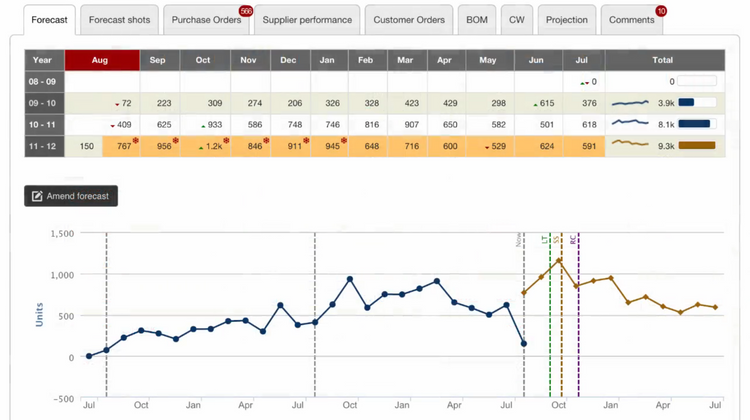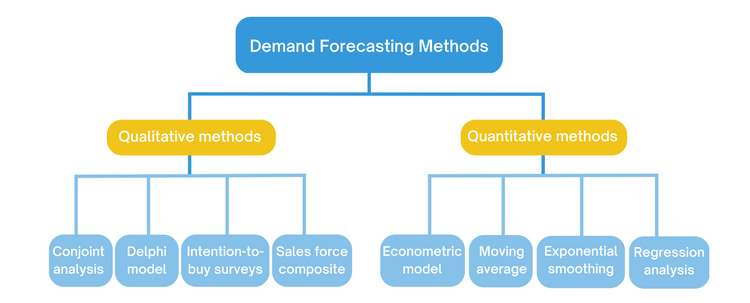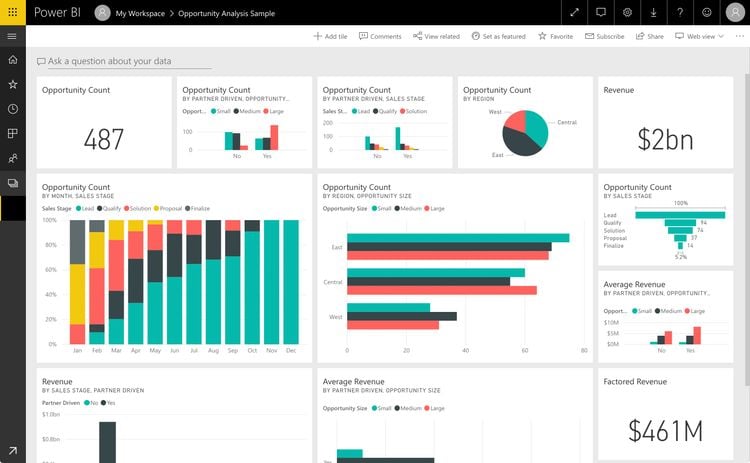Demand Forecasting: Methods, Types, and Examples
A complete guide to demand forecasting
Demand forecasting is the process of developing the best possible predictions of future consumer demand. Businesses can optimize inventory levels and pricing strategies using historical data, customer surveys, and expert opinions. Demand forecasting depends on accurate supply chain forecasting to meet those projected targets.
Key Takeaways
- Demand Forecasting Types: Active, passive, short-term, long-term, micro-level, and macro-level.
- Forecasting Methods: Qualitative (expert opinions and surveys) and quantitative (statistical data analysis).
- Benefits: Improved pricing, inventory management, and production planning.
- Challenges: Seasonality, limited data, and shifting market conditions.
Read on to compare the different types of demand forecasting, learn helpful techniques, and view examples you can apply to your own demand planning processes.
Want to streamline your demand forecasting? Explore the top BI tools for demand forecasting.
How to Forecast Demand
Despite the many different methods of demand forecasting available, the process follows a consistent set of steps:
-
Determine objectives. Clearly define the goals of your forecast and the outputs you require. For example, a relatively new fitness tech startup would want to forecast the optimal inventory levels for their product release or forecast which holiday seasons will increase demand.
-
Identify data sources. This could mean using internal sources like your inventory management software, ERP system, or sales spreadsheets for quantitative data. You could also conduct customer surveys or create focus groups for qualitative data.
-
Collect data. Pull information relevant to your forecast. This might include data collection on current market conditions, customer behavior, past sales data, stockout rates, and return rates for specific products. In the startup example, forecasters would need external, publicly available data as they do not have internal historical data to reference.
-
Utilize forecasting methods. Apply the appropriate qualitative or quantitative methods listed below to your data set. Qualitative methods use industry expert knowledge and customers’ opinions to inform demand projections. Quantitative forecasting uses hard data often compiled by software to predict future sales, seasonal demand, and customer behavior. Revisit steps two and three if you still need additional information to round out your forecast.
-
Analyze the data. Identify recurring trends across variables like consumer demographics, product categories, time zones, locations, and holidays. For instance, perhaps the startup decides to apply the active demand forecasting model to its data. The company observes an emerging market trend in their industry where customers prefer wearable health-tracking shirts to wristwatches.
-
Interpret results. Align your budget and business decisions with your findings, then track your sales performance against your original forecast. Make adjustments as you find discrepancies to improve forecasting accuracy. The startup may find that health monitoring shirts are a fad, with dropping sales over time throughout the industry. In that case, they might choose to offer more smart health watches instead.
Types of Demand Forecasting
There are numerous types of demand forecasting, and you can utilize more than one approach at a time. Below are the most common types:
-
Active forecasting bases projections on consumer behavior and market trends.
Use cases: Growing companies with aggressive growth plans and marketing/product development -
Passive forecasting is a forecasting technique that utilizes historical sales data to predict future demand.
Use cases: Established companies with steady sales -
Short-term demand forecasting examines trend projections over less than 12 months.
Use cases: Upcoming promotions (i.e., Black Friday/Cyber Monday sales) -
Long-term forecasting examines seasonal trends over more than 12 months.
Use cases: Expansion opportunities, business strategy development -
Micro-level forecasting models leverage data about specific industries and customer demographics.
Use cases: Granular market research -
Macro-level forecasting examines economic trends and external disruptions to commerce.
Use cases: Broad market research, expansion opportunities, potential market shifts
Demand planning software allows you to leverage internal marketing intelligence to generate various types of forecasts.

Main Forecasting Methods
The two main forecasting methods for demand forecasting are qualitative and quantitative forecasting. Qualitative forecasting is based on knowledgeable experts making predictions based on their own experience. Quantitative forecasting, also called statistical demand forecasting, uses historical data to predict future performance.
All forecasting models leverage data over a set period of time to estimate customer demand for a product or service. Here are eight of the most common demand forecasting techniques:
Qualitative
-
Conjoint analysis is a qualitative method using consumer surveys to identify the most desirable features of their products. Customers rank features based on their preferences, helping to analyze market potential for new products.
-
The Delphi model is qualitative demand forecasting that summarizes the individual findings of an industry expert panel. The experts review this summary and adjust their forecasts as needed, repeating the process until they reach a consensus.
-
Intention-to-buy surveys provide qualitative data on what consumers plan to purchase in the future. Ideal for short-term forecasting horizons, client intent surveys help generate sales forecasts based on how consumers answer.
-
The sales force composite method uses the collective opinion of salespeople to forecast demand in their territories. This qualitative approach uses direct experience with customers aggregated at either the branch or regional level.
Quantitative
-
The econometric model is a quantitative method identifying the relationships between economic trends. This technique pairs sales data with external economic forces to create a mathematical formula that predicts future customer demand.
-
Moving average: This method reviews historical data from a previous period to forecast the upcoming one, such as looking at demand from January to predict sales in February. The time periods can be any scale, such as a month, quarter, or year.
-
Exponential smoothing: Similar to the moving average method, this method accounts for the forecast of the previous period and the actual current demand to create a more accurate forecast. Exponential smoothing would take January’s forecast, see how accurate it was based on the finalized data, and then use the difference to make changes to the February forecast.
-
Regression analysis is a quantitative and statistical method that reveals the relationship between a dependent variable and one or more independent variables. This method shows how a forecast variable of interest relates to predictor variables.

Demand Forecast Examples
Let’s take two different approaches to demand forecasting based on scenarios businesses routinely face:
Active/conjoint analysis: A startup eCommerce business specializing in augmented reality glasses wants to expand its market share. Since it launched less than a year ago, the company does not have the historical data needed for passive demand forecasting.
Instead, the startup relies on the active demand method to base projections on consumer trends. An overall positive economic outlook shows consumers will have more disposable income for AR glasses. Also, a continuous increase in industry competitors will drive down pricing overall and push innovation and design.
The startup introduces conjoint analysis to its forecasting process, sending surveys to past customers to determine which product features they hold in the highest regard. Their findings show that to capture new consumers in an ever-expanding market, the next iteration of their product will need to boost battery life, utilize faster processors, and be more affordably priced.
Macro-level/Delphi method: A long-standing company selling Aubusson rugs has noticed a sales drop over the last year. They turn to macro-level forecasting to examine economic conditions and other external factors that might be responsible for this downturn.
Due to supply chain disruptions, a lack of wool and silk used to hand-weave the rugs has slowed an already laborious production process. In addition, inaccurate production planning led the company to deplete its on-hand inventory quickly, causing many consumers’ purchases to go on backorder.
The company uses the Delphi method to consult rug buyers and other experts about the outlook for the industry. The experts project that the global carpet and rug market will grow from 80 to 120 billion dollars over the next decade. They also determine that Aubusson rugs are going out of style in favor of cost-effective and sustainable alternatives. The company decides to shift production to machine-woven jute rugs, which are not only faster and cheaper to manufacture, but also currently trending in interior design.
Demand Driving Factors
There are various forces at play that all impact demand on some level. It’s critical to take these variables into account to avoid forecasting errors.
-
Competition: The more competitors are in your market, the more options your customer has when making a purchase. Features that are present in your product but not in your competitors’ could increase or decrease demand.
-
Economy: Demand for goods fluctuates depending on economic forces. For example, the demand for luxury goods might fall when the economy is performing poorly, but rise when the economy is strong.
-
Geography: Your customers’ locations impact demand, driving the need for anything from winter tires to dehumidifiers. The location of your manufacturers or shipping centers can also affect fulfillment and customer satisfaction.
-
Seasonality: Most industries face seasonality throughout the year, where order volumes change over time. For instance, demand for magnetic car sun shades will likely peak in warmer months, only to drop in cooler months.
-
Types of goods: Different products have different consumption patterns. Daily forecasting is needed for goods with a short shelf life, like fresh food, to help minimize spoilage and optimize sales. This differs from products like boating gear, which requires monthly forecasting to account for seasonal demand.
If you need help integrating various driving factors into your predictions, it might be worth investing in BI tools. Modern business intelligence software offers predictive analytics to help identify opportunities and project forecasts.

Benefits of Demand Forecasting
Accurate demand forecasting is essential to a company’s financial health, as it provides information critical to decision-making processes. Demand forecasting assists in the following areas:
-
Pricing strategy: Understanding the market and your competitors helps establish the best pricing for products and services.
-
Inventory management: Demand forecasting establishes targets for supply chain forecasting. These two processes help minimize backorders caused by carrying too little inventory, prevent rush charges associated with restocking, and reduce inventory carrying costs by estimating future demand.
-
Production scheduling: In coordination with accurate supply chain planning, forecasting helps manufacturers determine their optimal output rate based on demand and available resources.
-
Budget preparation: Invest the optimal amount of money into inventory so you have the cash flow needed to develop marketing campaigns or introduce new products and services.
Demand Forecasting Challenges
Both qualitative and quantitative forecasting methods have their own unique drawbacks and challenges. For example, a lack of historical data can make quantitative forecasting impossible. Similarly, a lack of responses to a Delphi survey can prevent a high-quality qualitative forecast. Other challenges include:
-
Changing regulations: Government regulations can change the production process, adding time to the supply chain. Businesses need to use forecasting to anticipate or react to demand changes.
-
Seasonality: Sales often change based on seasonal factors. Forecasting needs to address this, especially in season-dependent industries.
-
Not enough data: A lack of data can make quantitative forecasting impossible. This primarily impacts startups and new companies that simply do not have any viable data collected.
-
Skewed data: Similar to missing data, skewed data can also negatively impact forecasting. This might be tied to seasonality, unexpected disruptions, or other variables.
-
Product returns: When a product is returned, it indicates an unsatisfied consumer and unfulfilled demand. Failing to differentiate between actual products sold and returns can mess up future forecasts.
One way to address these challenges is to incorporate demand planning software into forecasting methods. These solutions help automate the process, coordinating data from sales, marketing, and operations departments to make more accurate predictions.
